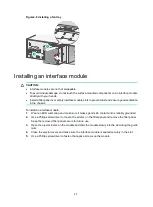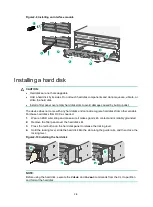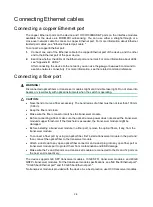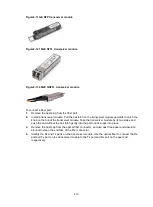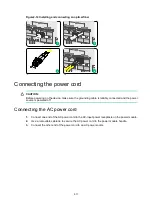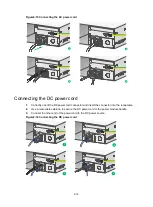
1-5
ESD prevention
To prevent electrostatic discharge (ESD), follow these guidelines:
•
Make sure the device and the workbench or rack are reliably grounded.
•
Take dust-proof measures for the equipment room. For more information, see "
•
Maintain the humidity and temperature at acceptable levels. For more information, see
"
•
Before working with the device, wear an ESD wrist strap or gloves and ESD clothing, and
remove conductive objects such as jewelry or watch. Make sure the wrist strap makes good
skin contact and is reliably grounded.
•
Place a removed component such as interface module on an ESD workbench or put it in an
antistatic bag, with its component side facing up.
EMI
All electromagnetic interference (EMI) sources, from outside or inside of the device and application
system, adversely affect the device in the following ways:
•
A conduction pattern of capacitance coupling.
•
Inductance coupling.
•
Electromagnetic wave radiation.
•
Common impedance (including the grounding system) coupling.
To prevent EMI, use the following guidelines:
•
If AC power is used, use a single-phase three-wire power receptacle with protection earth (PE)
to filter interference from the power grid.
•
Keep the device far away from radio transmitting stations, radar stations, and high-frequency
devices.
•
Use electromagnetic shielding, for example, shielded interface cables, when necessary.
•
To prevent signal ports from getting damaged by overvoltage or overcurrent caused by lightning
strikes, route interface cables only indoors. If part of the network cable of an Ethernet port must
be routed outdoors, connect a lightning arrester to the cable before you plug the cable into the
port.
Lightning protection
To better protect the device from lightning, follow these guidelines:
•
Make sure the grounding cable of the chassis is reliably grounded.
•
Make sure the grounding terminal of the AC power receptacle is reliably grounded.
•
Install a lightning arrester at the input end of the power module to enhance the lightning
protection capability of the power module.
Power supply
Verify that the power system at the installation site meets the requirements of the power modules,
including the input method and rated input voltage. For more information, see "Appendix A Chassis
views and technical specifications."





















